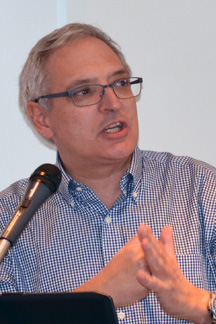Physician-Scientist Shares His Journey to Help Those with Autoimmune Diseases
By Madeline McCurry-Schmidt
Developing a drug and bringing it to market can take decades—from the trial-and-error research phase to the financial hurdles of putting a drug through clinical trials.
At The Scripps Research Institute (TSRI), Professor Hugh Rosen likes to think of Thomas Edison’s quote that genius is one percent inspiration and 99 percent perspiration. Even Edison faced many hurdles. “And he was a much smarter man than I am,” says Rosen.
Rosen’s sense of humor and persistence was evident at a recent “Frontiers in Science” lecture hosted by TSRI’s Office of Philanthropy, where he explained the highs and lows of discovering RPC1063, a drug candidate currently in mid- to late-stage clinical trials for multiple sclerosis and ulcerative colitis.
Finding the Right Molecule
Rosen’s journey at TSRI started in 2002. Attracted by “the minds, the innovation and the infrastructure,” he found TSRI offered something he could not find in industry: “You can persist in studying a disease long enough to actually solve it.”
When chemist Ed Roberts also joined the institute in 2005, they began collaborating. Rosen, an expert in the molecular mechanisms that regulate the immune system, has been involved in bringing two drugs to market. Roberts—whom Rosen calls a “chemistry savant”—has been involved in bringing five drugs to market.
The two researchers brought biology and chemistry together to find that a receptor called S1PR1 is critical in regulating the immune response, which goes awry in serious autoimmune diseases such as multiple sclerosis and ulcerative colitis.
Rosen and Roberts wanted to find a drug that could prevent progression of such life-altering diseases. Using a National Institutes of Health molecular library at Scripps Florida’s Molecular Screening Center, they found “hit” molecules with novel interactions with S1PR1, which led to an extensive chemical synthetic program that discovered and synthesized RPC1063.
After testing in animal models, the researchers concluded that the molecule had potential as a therapeutic. Rosen and Roberts went on to become scientific co-founders of Receptos, the company that would run the clinical trials for RPC1063.
Discovery of the molecule occurred around the time of the 2008 Lehman Brothers crash. “This was an extremely difficult interlude because we really felt strongly about RPC1063,” said Rosen, “but we remained confident that a molecule that could transform the lives of patients should survive a down market.”
Would Patients Respond?
Some investors were indeed willing to take a chance on Receptos, and human clinical trials on RPC1063 began in 2011. The results so far have been encouraging.
In September 2014, Receptos announced that, in a six-month Phase 2 study of 258 multiple sclerosis patients, RPC1063 reduced the relapse rate of participants with multiple sclerosis by up to 53 percent, compared with placebo. The potential therapy also decreased the emergence of new brain damage seen by magnetic resonance imaging (MRI) by more than 90 percent.
And in October 2014, Receptos released the results from a Phase 2 study with 199 patients with active, moderate-to-severe ulcerative colitis. The data showed that after eight weeks of treatment with a 1-milligram dose of RPC1063, 16.4 percent of patents were in clinical remission, as compared to 6.2 percent of patients on placebo.
In both studies, patients have reported no notable adverse events, and researchers have found no evidence of heart or liver damage, a side effect of some multiple sclerosis drugs currently on the market.
“To see something like that is a physician-scientist’s dream,” said Rosen.
The next step is to gather data from longer-term studies. By 2017, Receptos will have the results of one- and two-year studies with more than 2,400 multiple sclerosis patients worldwide. If the drug succeeds, it could be on the market as a treatment from multiple sclerosis in 2018, exactly 10 years after RPC1063 was identified.
Clinical trials for ulcerative colitis are also continuing, and a new trial for Crohn’s disease—another inflammatory bowel disease—is being launched.
A Commitment to Research
Rosen’s journey struck a chord with audience member Doug Diamond, an applied economist who supports Alzheimer’s disease research and follows developments in the biomedical sciences. “Normally, in academia, a scientist would only be involved in the beginning,” said Diamond. “You just know there are so many hurdles, and Dr. Rosen is still engaged and involved.”
For Rosen, the knowledge that his work could help patients has kept him going. “As a physician-scientist, the patient always comes first,” he said. “That is the mission that really drives everything.”
More information about the “Frontiers in Science” lecture series, which will continue in 2015 under the new name “At the Forefront,” will be posted on www.scripps.edu.
Send comments to: press[at]scripps.edu














